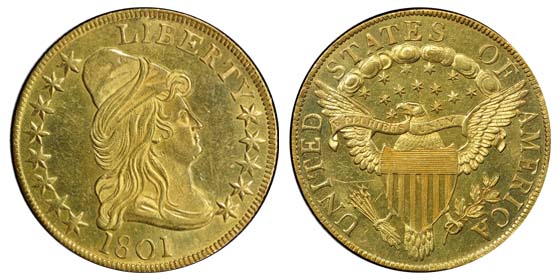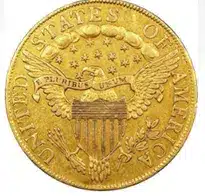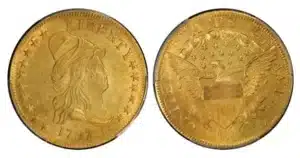Turban Head Gold Eagle Values
How Much Turban Head Gold Eagles are Worth:Turban Head Gold Eagle Values & Coin Price Chart

Year | Mint | Variety | Designation | VG-8 | F-12 | VF-20 | EF-40 | AU-50 | U-60 | MS-63 | MS-64 | MS-65 | MS-66 | MS-67 |
|---|---|---|---|---|---|---|---|---|---|---|---|---|---|---|
1800 | P | Plain 4- Stemless Wreath | Red-brown | 200 | 300 | 400 | 500 | 600 | 700 | 800 | 900 | 1000 | 1200 | 1100 |
| Year | Mint | Variety | Designation | VG-8 | F-12 | VF-20 | EF-40 | AU-50 | MS-60 | MS-63 | MS-64 | MS-65 | MS-66 |
|---|---|---|---|---|---|---|---|---|---|---|---|---|---|
| 1795 | (None) Phil | 13 Leaves, 400-600 Known, SRS: R2+ | -- | $32,500 | $34,850 | $43,150 | $67,200 | $98,800 | $188,800 | $403,200 | $777,000 | $1,397,500 | $2,350,000 |
| 1796 | (None) Phil | 125-175 Known, SRS: R4 | -- | -- | $29,700 | $36,300 | $64,700 | $76,300 | $151,300 | $471,020 | -- | -- | -- |
| 1797 | (None) Phil | Small Eagle, 50-60 Known | -- | -- | $39,600 | $52,800 | $80,750 | $115,375 | $271,000 | $478,500 | -- | -- | -- |
| 1797 | (None) Phil | Large Eagle, 200-250 Known, SRS: R3+ | -- | -- | $11,000 | $16,675 | $26,550 | $36,800 | $72,500 | $242,000 | $308,000 | -- | -- |
| 1798/7 | (None) Phil | 9x4 stars. 80-100 Known, SRS: R4+ | -- | -- | $12,100 | $17,050 | $45,375 | $64,150 | $159,000 | $356,750 | -- | -- | -- |
| 1799 | (None) Phil | Large stars Obverse, 300-400 Known, SRS: R3+ | -- | $10,000 | $10,950 | $12,610 | $17,425 | $19,800 | $33,750 | $76,380 | $151,150 | $254,500 | $545,000 |
| 1799 | (None) Phil | Small Stars Obverse, 400-550 Known, SRS: R3 | -- | $10,000 | $10,950 | $12,610 | $17,797 | $20,240 | $34,438 | $78,800 | $191,500 | $268,800 | $440,000 |
| 1800 | (None) Phil | 200-300 SRS: R3+ | -- | -- | $9,900 | $12,610 | $17,425 | $19,800 | $36,500 | $88,500 | $338,750 | $445,250 | -- |
| 1801 | (None) Phil | 650-850 Known, SRS: R3+ | -- | $10,000 | $10,950 | $12,610 | $17,425 | $19,800 | $33,750 | $73,300 | $151,150 | $254,500 | -- |
| 1803 | (None) Phil | Small Reverse Stars, 200-275 Known, SRS: R3+ | -- | -- | $12,100 | $14,375 | $18,525 | $24,750 | $44,000 | $89,600 | $200,500 | $487,500 | -- |
| 1803 | (None) Phil | Large Reerse stars, 100-120 Known, SRS: R4+ | -- | -- | -- | -- | $19,225 | $24,750 | $44,250 | $73,300 | $102,300 | $209,000 | $440,000 |
| 1804 | (None) Phil | Crosslet 4, 80-100 Known SRS: R4+ | -- | -- | $22,000 | $28,600 | $43,700 | $58,900 | $145,250 | $391,250 | $600,000 | -- | -- |
| 1804 | (None) Phil | Plain 4, 4 Known | -- | -- | -- | -- | -- | -- | -- | $2,525,000 | $3,230,000 | $3,960,000 | -- |
Description and History
The first Chief Engraver of the United States Mint, Robert Scot, created all three of the designs for the first US $10.00 Gold Eagles – one obverse design and two reverse designs, a small eagle and a heraldic eagle. All three gold coin denominations used these same designs. Scott heard the public and US Mint’s criticisms of his small eagle design (called a “Scrawny Eagle”) and set about to remedy the critique.
He modeled the new eagle after the design on the Great Seal of the United States. The eagle, being the central vignette, was much more majestic than in his small eagle design. It more gloriously represented the new nation.


Scott did not modify the obverse design from his first design. He kept Miss Liberty wearing a turban-like hat, facing to her right. Above her, on the periphery, was the word “LIBERTY” and there were five six-pointed stars to the right and eight six-pointed stars to the left. The date is under Miss Liberty. The new Heraldic Eagle design had the eagle facing left, with a scroll in her mouth on which was inscribed “E PLURIBUS UNUM.” Surrounding the eagle’s head were 13 six-pointed stars. Above the stars was a bank of clouds. Around the periphery of the coin was “UNITED STATES OF AMERICA.” No denomination was started on these early gold coins and Scott’s modified eagle was much more successful and the design received praise instead of scorn.

So during the first year of the new design – 1797 – the Philadelphia Mint struck 10,940 coins. The next year, 1798, the mint struck only 900 coins that were struck as an 8/7 overdate but had nine six-pointed stars to the left and four six-pointed stars to the right. They also struck 842 examples on the other variety for 1798, which was also an 8/7 overdate with seven six-pointed stars to the left and six six-pointed stars to the right.
The year 1799 saw two varieties struck between the 37,449 coins – one with Small Obverse Stars and the other with Large Obverse Stars. They are about equal in value and no one knows exactly how many of each were struck. In 1800 production dwindled to 5,999 coins and in 1801 minting soared to 44,344 coins, the most struck in this series. No 1802-dated coins were struck. In 1803, two varieties were struck among the 15,017 coins minted – one with Small Reverse Stars and the other with Large Reverse Stars.
There were a total of 3,757 eagles dated 1804 that was struck in that year. They are called “Crosslet 4” coins because they have short vertical extensions of the cross-stroke at the end. Although over 3,700 coins were minted, very few are known to exist today.
In 1834, the Government intended to present a set of then-current US coins to four Asian rulers with whom they hoped to open trade relations. Although this was 30 years later, neither a $10 Gold coin nor a Silver Dollar had been struck since 1804. The US Mint Director was pressured to strike 1804-dated $10 gold eagles and silver dollars specifically for these sets. Four of each of these two coins were struck and the sets were completed and encased in wood, leather, and the four coins struck for these four sets where all of the “Plain 4” variety with no Crosslet and they were struck in Proof condition.
Two sets were presented to the King of Siam and the Sultan of Muscat and Oman. But the two remaining sets were never presented as the US diplomat died of disease. The existence of all four sets is known today, with three in private hands and the fourth in a museum.

